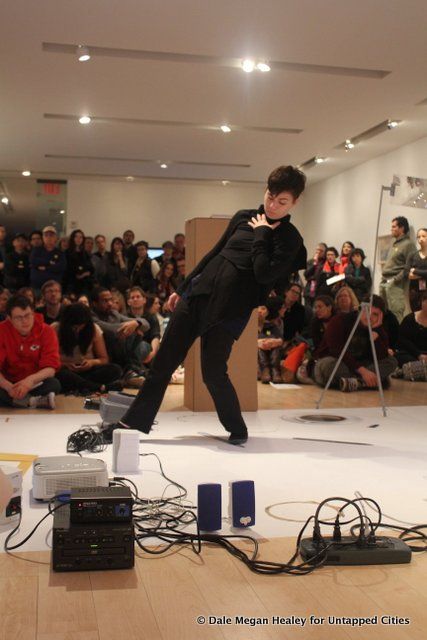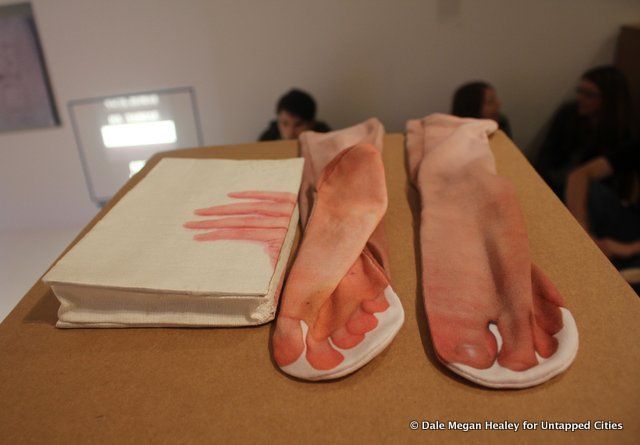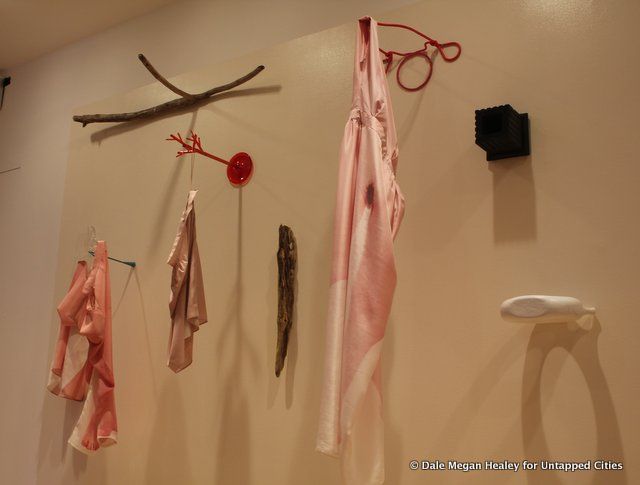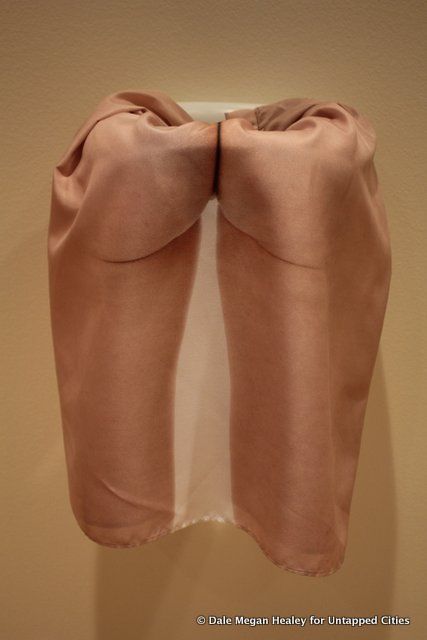How to Make a Subway Map with John Tauranac
Hear from an author and map designer who has been creating maps of the NYC subway, officially and unofficially, for over forty years!


Georgia Sagri’s performance, Working the No Work in the Whitney Biennial, begins when she emerges from behind a cardboard door that resembles a homemade structure in a child’s playroom. You might consider that it begins even earlier, when she enters the gallery itself, saying, “It is going to be a little late.” Perhaps the performance begins even before that, when the spectators enter the gallery and look around at the objects in the room. As it grows quiet and becomes clear who the audience should pay attention to, Sagri taps her feet and slowly approaches a laptop on the floor. She curls her body over the keyboard and records the sound of herself retching. She walks around the room making the same tortured sounds so that they can be recorded from different distances. They begin to play on a loop as she herself becomes quiet, and she moves her body with the rhythm of the retching.

By now, she has taken off her black cotton outfit. Hanging against the wall are pants, a T-shirt, a skirt, and a jacket, which all depict the life sized form of a woman’s nude body. When she puts on each outfit, she appears to be wearing her own body (and it is, indeed, Sagri in the images). She takes a moment to stare down at the breasts as if they are foreign, as separate from her own chest as any design on a T-shirt. Wearing this synthetic skin, she acts out the looped retching sounds, bending over to clutch her stomach and sticking out her tongue as if she is vomiting.
I saw her give a talk as part of Columbia’s Xtracurricular series three days before I actually saw her perform. I was worried that I may have experienced Sagri’s performance backwards, but perhaps this way of witnessing her was just as appropriate as any. It was like I was cheating, skipping to the explanation rather than experiencing the action. I imagined that some people in the Columbia audience might’ve been puzzled Whitney patrons who’d seen the performance piece and wanted a longer explanation. A slideshow of photos from Working the No Work ran behind her as she began to speak, and I thought perhaps I should leave, not wanting to ruin the show for myself.
But the talk was more about what performance means to Sagri in general, rather than an explanation of this specific piece. In fact, when someone asked if she could tell us a bit about the pictures projected behind her, she answered, “They are just background,” and went on to the next question. The woman sitting next to me told me she thought that this response was a little unfair. In fact, Sagri comes across as a bit solemn, while there is so much fun and wackiness in her performance. She just takes presence very seriously, and defends the right for the performance to speak for itself.

The title, Working the No Work, refers to a struggle against working for a boss or an organization so distant from the self. Sagri, who was born in Athens in 1979, was one of the original attendees of the Occupy Wall Street General Assemblies this past summer, and her work makes constant reference to situationism and to modern Greek anarchists. She told us that the Greek word for space is often used to refer to “the people,” in situations of protest or demonstration. Therefore, her performance space becomes a space of living people, acknowledging that every peripheral witness is a contributing author. In her lecture, she expressed a dilemma between working through representation rather than existing as a presentation. “How do you articulate ‘no authority’ in a performance when performance itself is all about authority and center?” she asked. In her performance, she steps over spectators in the room, makes eye contact, and silently reaches her hands out to people if they begin to leave before it is over. People wander in and out, and even the security guard seems at ease, smiling at the more bizarre moments.

As Sagri moves, footage from different spaces around the Whitney is projected against a wall, along with rolling credits, and text in the format of the Star Wars opening crawl. Those credited as “Contributors” (in no discernible order) include Plato, Martha Rosler, Lady Gaga, someone listed only by their first name, “Micah,” Pierre Paolo Pasolini, among many others. She seems to be, in part, handing her authority not only to the spectators in the room, who influence her work in the present, but every person who influenced her before, whether from personal relationships, or artists from decades ago. She is not the only author of the piece and she shows how these authors coexist within her body. They have contributed to the present performance by contributing something to a public, collective knowledge.
 Socks and clutch from Sagri’s installation.
Socks and clutch from Sagri’s installation.
The installation and the performance are continuously evolving, with the endpoint being the creation of a book. It seems that Sagri does not intend to assemble a physical book, however. She uses the metaphor of the book to explore the blurring of the role of an author. Distinctions between an author and a reader, a producer and a product are no longer significant. Reading and witnessing are part of the action. She is writing and editing through her movements. There are no spoken words in the performance, (at least in the one I attended) but she still refers to it as a “discussion.” At the Columbia talk, she described watching a performance, telling us, “You begin to recognize yourself through someone else’s movement.” I couldn’t help but think of the way we recognize our own words and thoughts when we read a good book.

In Working the No Work, she imitates different versions of herself as she moves under the layers of her own body. She changes her clothes over and over, and sings or whispers to make more looped sounds to dance to. Some movements are gentle, others are harsh, such as throwing herself against a wall, shouting, “Ow, ow, ow!” The movements reach a kind of climax, and then descend as she expresses her exhaustion. She puts on a pair of glasses with pictures of her own closed eyes in the frames, and lies down on the floor to rest. She closes the performance when she changes back into her black outfit, hangs the cloth limbs on the wall, and leaves.
 Sagri’s garments as well as the pillows in the installation, are designed by Brooklyn-based eco- fashion designer Shabd Simon-Alexander.
Sagri’s garments as well as the pillows in the installation, are designed by Brooklyn-based eco- fashion designer Shabd Simon-Alexander.
While she might share her authority with those who influenced her, every echo, every movement, undoubtedly comes from Sagri. “I do not understand performance but I understand the myth of Narcissus and Echo,” she told us at the Columbia lecture. In this myth, of course, Echo is disabled from speaking her own words and can only repeat the words of others. Sagri noted that the mirror image and the echo are almost the same, but the mirror destroys Narcissus, while Echo only grows and reaches farther into the world. Sagri recognizes herself as an embodiment of voices, other echoes, while reminding us that she is still wearing her own body. The looped sounds move farther from her voice until they begin to sound like objects. Still, the visual presentation reminds us that the sounds originated from the human body in front of us, not from the laptop. “Action happens from searching for the other through an echo of ourselves,” she said at Columbia. “Echo doesn’t know herself. She is always repeating what others are saying, but then that becomes herself.”
In her lecture, she compared her way of performing to copying and pasting on a computer. The digital loops make copy after copy of something other than her voice, a kind of ghost in the machine, while we are constantly reminded of her presence and physicality. She talked about property and authorship becoming less and less tangible in the digital world, and considered that this way of looking at ownership might somehow become a part of our behavior in the social world as well. How can we know a place if we only consider what it has been named for, or who it belongs to, rather than who walks through it? Can we get to know each other better if we call the people and things that influence us the “authors” of ourselves? She described a scenario of two people meeting, and considered that instead of asking, “What do you do?” someday we will ask a question that is much more “plural” and integrative. More than anything else from the lecture, I held this scenario in my mind as I watched the performance. What would be a more integrative question for getting to know someone? Naturally I think of replacing, “What do you do?” with “Who are you?” but this also seems too easy, and might be just as limiting. In my own attempts to fully witness and understand performance art that is intentionally cryptic or difficult to access, this scenario seems like a useful tool. Performance art pushes us to look, (and read) in a way we might’ve not known we could. It can puzzle us, provoke us, and force us to recognize ourselves in places where we are not. It is a way of asking, “Who are you?” and getting an answer that is more than just one person’s own name.
 Sagri’s skirt, after her performance.
Sagri’s skirt, after her performance.
Working the No Work will be at the Whitney until May 27th. Sagri performs on Sundays at 1pm, as well as select Fridays: March 9 and 16; April 27; May 18, all at 7pm.
Follow Untapped Cities on Twitter and Facebook! Get in touch with the author @untappeddale.
Subscribe to our newsletter